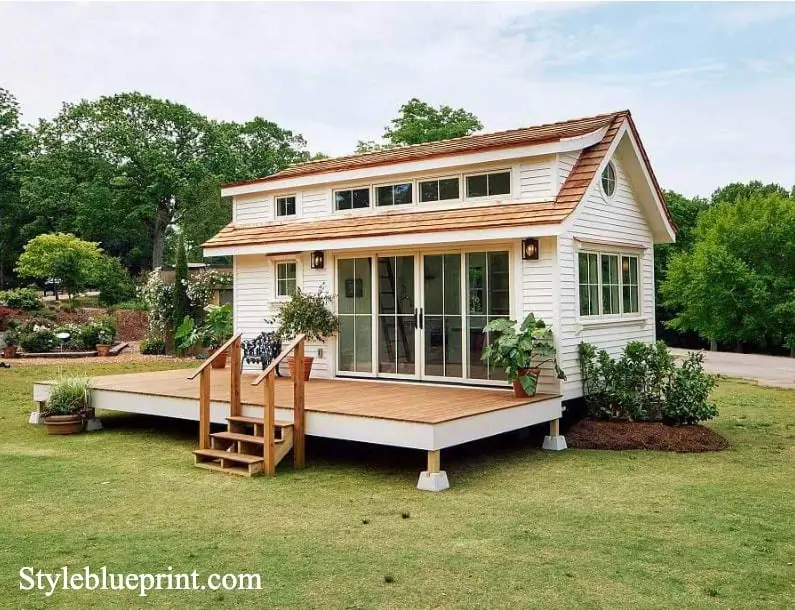Over the past few years, the tiny house movement has gained momentum as more Americans seek affordable and sustainable living options.
In fact, the U.S. has a shortage of 7.3 million rental homes affordable and available to renters with extremely low incomes.
This is referred to as the Missing Middle.
The allure of reducing housing expenses, downsizing and embracing a minimalist lifestyle serves as a driving force for those considering tiny homes.
This article aims to provide insight into the types of people residing in these compact spaces through general statistics, market trends, and popular tiny home characteristics.
- Tiny home statistics demonstrate a growing interest in this eco-friendly, affordable housing option.
- Market trends reveal various demographics choose to live in tiny houses for diverse reasons, including environmental and/or financial reasons.
- The tiny home market is expanding, with prospects including continued growth and greater industry attention due to affordability and sustainability.
- Tiny homes are gaining popularity and vendors are now specializing in building tiny homes.
- Tiny Home Communities are growing in response to the demand of a place to park a tiny home.
Disclosure: This post may contain affiliate links, meaning I can earn commissions. If you decide to purchase through my links, it is at no cost to you.
What are Tiny Homes?
One of the defining characteristics of tiny homes is their size.
Tiny homes are smaller than traditional ones and designed to use limited space while efficiently providing a comfortable living environment.
They offer a more affordable and environmentally friendly alternative to traditional housing and have garnered significant interest in recent years.
As more and more people discover the advantages of tiny house living, the movement is expected to continue growing and evolving.
According to the International Code Council’s Residential Code, the minimum acceptable ceiling height for habitable spaces in tiny homes is 6 feet 8 inches.
Not only do tiny homes function as primary residences, but they can also serve as vacation homes, guesthouses, or workspaces. Some choose to go tiny in retirement to save on expenses and gain freedom.
They encourage minimalism, eco-friendliness, and simplicity in an increasingly materialistic and consumer-driven world.
Tiny house festivals have played a significant role in the rising popularity of tiny homes, offering enthusiasts a chance to explore and learn about these unique living spaces.
General Tiny Home Statistics and Facts
- The concept of tiny houses can be traced back to 1845, when Henry David Thoreau built the first one. [2]
- Today, it’s estimated that there are more than 10,000 tiny homes in North America. [24]
- Some seem to think a tiny house can last 30-50 years but no one really knows.
- On Airbnb, there are 60,000 tiny homes available as unique stay experiences. [3]
- Typically, a tiny home’s size ranges from 100 to 399 square feet (205 sq ft on average), about six times smaller than an average house. [1][4]
- Tiny homes are more environmentally friendly, producing fewer CO2 emissions annually than average-sized homes. [5]
- The average cost of a tiny home is $52,000, making it 87% cheaper than the average price of a standard U.S. home. [7]
- Tiny homes must have a minimum ceiling height of 6 feet 8 inches in habitable rooms and not less than 6 feet 4 inches in bathrooms, kitchens, and toilet rooms. [2]
- Tiny home living is motivated by various factors, such as environmental concerns, financial needs, and a desire for simplicity. [15]
- Some cities are building tiny house villages to address homelessness in their communities. [25]
- Using a waterless toilet in a tiny home can reduce water usage by 27%. [30]

Notably, most tiny house owners experience less financial strain, with more than 80% having less debt than the average U.S. citizen. [8]
Other interesting aspects of the tiny home demographic include:
- Approximately 40% of tiny homeowners are above 50 years of age. [9]
- Women comprise 55% of the tiny house ownership population. [9]
Trends and Affordability of Tiny Houses
Tiny homes are increasingly seen as an affordable housing option due to the rising costs of renting a home.
- The tiny home movement has captured the attention of many individuals who desire a more sustainable and affordable lifestyle.
- Reduced ecological footprints are one of the main driving forces behind adopting tiny homes.
- Among the challenges tiny homeowners face are legal issues and limited space availability for construction, which are some of the most prevalent issues, as highlighted in this study.
Related Articles 📚
Most tiny homes have one or two bedrooms, a bathroom, and a kitchen designed to maximize efficiency and functionality.
They often feature multi-purpose furniture and innovative storage solutions, resulting in a minimalist and decluttered living environment.
- Tiny Homes are shaping housing policies and offering a potential solution to homelessness by providing affordable housing options for those in need.
- Numerous tiny home communities have been successfully established, such as The Dwellings in Tallahassee, FL, which provide a sustainable living environment for their residents.
The trend is particularly strong in North America, where affordability drives the growth of the global tiny house market.
Key Trends
- Off-grid living: Many tiny homeowners opt for off-grid living, relying on solar power and rainwater collection systems to reduce their dependence on conventional utilities. This enables them to live self-sufficiently. The use of composting toilets is often one of the aspects of tiny house living.
- Minimalist living: The small size of tiny homes encourages a minimalist lifestyle, often prompting owners to reduce their belongings and focus on items that contribute to their overall well-being.
- Multi-functional spaces: To maximize the efficient use of limited space, homeowners often opt for multifunctional spaces within their homes. Examples include multipurpose furniture, retractable sleeping areas, and convertible storage spaces.
- Alternative financing methods: Due to the unavailability of mortgage finance for tiny homes, owners have turned to alternative financing methods such as cash, short-term loans, and mortgages on the land on which the tiny home is built.
Statistics of Affordability of Tiny Homes

- Estimated compound annual growth rate of 4.88% for the tiny homes market between 2022 and 2027. [10]
- The tiny house market is projected to grow by $4.17 billion by 2027. [10]
- North America is expected to contribute 57% of the growth in tiny homes by 2027. [10]
- 56% of Americans would consider living in a tiny home if given the opportunity. [11]
- The average cost of a tiny house ranges between $30,000 and $60,000, with some as low as $8,000 and others as high as $150,000. [12]
- Arkansas, Kansas, Mississippi, Kentucky, and Missouri are all states where tiny homes are available for less than $40,000. [13]
Most tiny homes are funded by cash, short-term loans, or mortgages on the land only. When it comes to tiny home ownership and finances, the following statistics showcase how tiny homes can provide fiscal benefits:
- 68% of tiny house owners don't have a mortgage, compared to 29.3% of all U.S. homeowners. [9]
- 55% of tiny house owners have more savings than the average American.[9]
- 32% of tiny house owners have over $10,000 saved for retirement.[9]
The tiny home trend is especially popular among millennials, who appreciate the affordability and minimalism of owning a smaller living space.
Market players capitalize on this growing interest, offering various tiny home options for personal and commercial use.
Characteristics of Tiny Houses

Tiny homes come in two main types: mobile tiny homes and stationary tiny homes.
- Around 54% of people prefer mobile tiny homes, making them popular among potential tiny homeowners. [11]
- A composting toilet breaks down waste to 10 to 30% of it's original volume. [29]
- Moisture levels in a composting toilet should be maintained within the range of 40-70%, with the optimum being 60%. [29]
Some of the reasons why Americans are attracted to tiny homes include affordability, efficiency, eco-friendliness, and a minimal lifestyle.
Regarding desired amenities, heating/AC and kitchen space are on top of the list. [11]
Habitable space specifications for tiny homes can be found in the International Code Council guidelines, ensuring safety and quality construction.
To better understand Americans' preferences for tiny homes and backyard offices, you can refer to this survey conducted by Investment Property Exchange Services, Inc.
A Backyard Tiny Office
As remote work becomes the new norm for numerous Americans, the allure of the "tiny office" or "backyard workspace" is rising.
These compact spaces offer a refreshing departure from conventional home offices or makeshift setups in living rooms and kitchens.
Most people consider 200-299 sq ft the ideal square footage for a tiny office. - IPX1031.
Interestingly, 54% of individuals expressed interest in purchasing such a tiny office, with 62% of remote workers contemplating the idea.
On budgeting, over a quarter of those surveyed indicated a willingness to invest up to $8,000 for their cozy backyard workspace.
Demographics of Tiny Homeowners

Characteristics of People Living in Tiny Homes
The small size and affordability of tiny homes attract people from various backgrounds and diverse demographics.
Although these demographics offer a snapshot of the typical tiny home resident, the tiny home movement continues to evolve and expand, welcoming individuals from all walks of life.
Here are some common features of tiny homes and their residents:
- Small living spaces, typically under 500 square feet. [16]
- Space-efficient designs with multi-functional areas. [17]
- Focus on sustainability and minimal environmental impact. [18]
- Many tiny house owners have higher education, with twice the likelihood of holding a Master's degree. [9]
Age and Gender Distribution - Breakdown by age groups and gender

The age and gender distribution of tiny homeowners varies as the movement attracts a diverse demographic.
While specific data on age and gender is limited, it is clear that Tiny Living is appealing to a wide range of people, including:
- Age distribution in the tiny home community shows a diverse demographic: roughly 40% are over 50, another 40% fall within the 30-50 age range, and about 20% are under 30 years old. [9]
- Young couples and single individuals are looking for affordable housing options. [9]
- Older adults are seeking to downsize as they enter retirement.[9]
- Eco-conscious individuals who wish to live a minimalist lifestyle. [9]
Income Levels

The income levels of tiny homeowners can differ quite a lot. Many tiny home dwellers are drawn to this lifestyle due to its affordability.
Some key points about tiny homeowner income levels include:
- The average annual income for tiny home residents is $42,038. [9]
- Lower overall cost of living compared to traditional homes. [19]
- Greater flexibility in terms of location and lifestyle choices. [20]
- Some homeowners invest in tiny houses to save money or pay off debt. [21]
Economic considerations of tiny homeowners
Economic considerations play a significant role in living in a tiny home. The lower cost of living, financial flexibility, and potential for savings are all factors that can attract people to the tiny house movement.
Key considerations for tiny homeowners include:
- Homeownership is more common among tiny home dwellers, with 78% owning their own home, as opposed to 65% of traditional homeowners. [9]
- 86% of homeowners consider purchasing a tiny home for their first home. [11]
- Up to 93% lower electricity bills due to the smaller space and energy-efficient designs. [22]
- Potential for a mortgage-free lifestyle, depending on the financing options available. [23]
- Lower property taxes, as tiny homes often fall into a different tax bracket than traditional homes. [23]
- Rural areas are seeing the most significant buying interest in tiny homes. [11]
- North Dakota is the least expensive state for tiny home purchases. [13]
Tiny House Environmental Impact Statistics
Tiny houses offer numerous environmental advantages mainly due to their small size and the sustainable approach employed in construction. Here are some significant statistics highlighting these benefits:
- Cooling the average home generates about 4,000 pounds of CO2 per year compared to just 286 pounds of CO2 per year for tiny houses. [31]
- A tiny home consumes merely 7% of the energy utilized by a traditional house.[22]
- By reducing the greenhouse effect, tiny homes are 36% more eco-friendly than standard-sized homes. [14]
- Construction of a tiny house requires fewer materials and consumes less water, gas, and electricity than traditional homes. [14]
The tiny house movement also promotes a more sustainable lifestyle, reducing waste and focusing on living with fewer material possessions.
The efficient utilization of resources in building and maintaining these small homes contributes greatly to preserving the environment.
Affordable Housing Strategy
The study titled "It Takes a Tiny House Village: a Comparative Case Study of Barriers and Strategies for the Integration of Tiny House Villages for Homeless Persons in Missouri" focuses on the potential of tiny house villages to solve homelessness.
It particularly examines two case studies in Missouri: Eden Village in Springfield and Veterans Community Project (VCP) in Kansas City.
- Approximately 150,000 families with 330,000 children stay in homeless shelters each year in the U.S. [27]
- Tiny house villages are generally cost-effective. [27]
- It costs taxpayers between $30,000 and $50,000 per year to leave a "chronically homeless" person on the street. [27]
- A tiny house village costs between $12,500 and $15,000 per person per year. [27]
Who Built The First Tiny House?
Henry David Thoreau is often credited with building the original tiny house, showing that the tiny house movement dates back to the 19th century.
However, it is important to note that tiny homes have evolved significantly since then regarding design and purpose.
In recent years, tiny homes have gained the attention of diverse homeowners, environmentalists, and some policymakers.

Future Trends and Forecasts
Market Projections and Research Reports - Future growth potential and emerging patterns
The tiny home movement has been gaining popularity over the last decade and has captured the interest of many people looking for a sustainable and affordable way of living.

In this section, we will explore the future trends and forecasts for the tiny home market.
- One of the reasons behind the growing popularity of tiny homes is the increasing concern for environmental sustainability. As more people become aware of the need to reduce their carbon footprint, the demand for efficient, eco-friendly housing options like tiny homes is expected to grow.
- Affordable housing has become a significant issue in many countries, and tiny homes offer a viable solution to this problem. As the cost of living continues to rise, more people might opt for tiny homes as an affordable alternative to traditional housing.
- Technological advancements are playing a big role in the development of tiny homes. New materials and innovative design solutions are making it possible to create compact yet comfortable living spaces. Smart home technology also makes its way into tiny homes, offering greater energy efficiency and improved functionality.
A recent research report suggests that the global market for tiny homes will experience significant growth in the coming years.
The increasing interest in minimalist living, concerns for the environment, and the need for affordable housing are expected to drive this growth. [26]
The tiny home trend shows no signs of slowing down. As market trends continue to lean towards sustainability and affordability, likely, the popularity of tiny homes will only continue to rise.

Key Players in the Tiny Homes Market
The tiny homes market has grown significantly over the past few years, with several key players driving the industry forward.
These market movers are known for their innovation and commitment to sustainable living. The following are some of the important entities in the tiny homes arena:
- Tumbleweed Tiny House Company: Established in 1999, Tumbleweed is considered one of the pioneers in the tiny homes market. They have a wide range of customizable designs and constantly innovate to meet the changing demands. The Tumbleweed TIny House Company has built a reputable brand focused on sustainable and minimalistic living.
- Tiny Home Builders: Founded in 2009 by Dan Louche, Tiny Home Builders is another key player. They offer comprehensive guides, workshops, and custom-designed tiny home models. Tiny Home Builders emphasizes the educational aspect of tiny living, helping people learn about the benefits and challenges.
- New Frontier Tiny Homes: This company is recognized for its luxurious designs and high-quality materials. They provide a different approach to tiny living, combining modern architecture with functionality. New Frontier creates homes with strong aesthetic appeal while maximizing comfort and efficiency.
- Tiny Heirloom: Tiny Heirloom is a family-run business based in Portland, Oregon, specializing in luxury custom tiny homes. They focus on quality construction and innovative design, aiming to bridge the gap between downsizing and upgrading. They offer features like solar setups and use 100% renewable energy in their building process.
The following statistics provide a glimpse into the tiny homes market:
- The average size of a typical tiny home is between 100-400 square feet, making them significantly smaller than traditional homes.
- A 40% increase in tiny houses seeking land in Rotterdam was observed recently, indicating a growing interest in sustainable living.
- The tiny house movement has successfully led to the growth of several related industries, such as home accessory firms that focus on storage solutions and innovative designs.
The key players in the tiny homes market have significantly impacted the housing industry, popularizing the concept of sustainable and minimalistic living.
Their continuous innovation and commitment to the movement have influenced both the market and the quality of options available for tiny home enthusiasts.
What is the Tiny Home Movement?
The tiny home movement has gained significant traction in recent years as more individuals embrace living more simply and sustainably.
These small residential structures, usually 100 to 400 square feet, provide a versatile and efficient dwelling solution that challenges traditional norms of large houses with excessive space.
They provide their owners with a more minimal lifestyle, focusing on reducing both their carbon footprint and financial burdens.
In this growing market, various trends and statistics reveal the factors driving the interest in tiny homes and how they appeal to a wide range of demographics.
One important aspect propelling the tiny home movement is the environmental impact and potential for reduction in carbon footprint.
Tiny homes typically use fewer materials during construction, reducing waste and improving energy efficiency.
In addition, their smaller size allows for more sustainable living through decreased energy consumption and the possibility of incorporating alternative power sources, like solar or wind energy.
Tiny homeowners' demographics span various age groups and income levels, showcasing the appeal of compact living to a widespread audience.
Future Prospects of the Tiny Homes Industry

The tiny homes industry has seen significant growth in recent years, offering intriguing prospects for sustainable living and presenting various challenges.
In this section, we will examine several key factors that indicate the future direction of the tiny homes movement.
- Market demand: The demand for tiny houses in North America has been steadily increasing, which can be attributed to affordability, eco-friendliness, and downsizing desires. This trend will continue as more people prioritize minimalist, sustainable, and community-led lifestyles.
- Sustainable development: Tiny homes contribute to a lower carbon footprint, energy conservation, and overall sustainable development. The industry's growth may contribute to integrating environmentally friendly practices and materials, a positive direction for combating climate change.
- Land use policy changes: As the tiny homes movement expands, land use policies must be reevaluated to accommodate the growing demand for smaller housing. Including tiny homes in urban planning may lead to more flexible zoning regulations and innovative solutions for optimal city living.
- Technological advancements: Advancements in technology will play a vital role in further developing the tiny homes industry. Smart home technologies and space-saving innovations will make small homes more functional and adaptable to individual needs.
Final Thoughts
In conclusion, the tiny home movement continues to grow as more people embrace its benefits.
While certain challenges remain, the potential advantages of tiny homes warrant further exploration in policy-making and practical applications, as well as encouraging additional research on their long-term impact on sustainable living and urban development.
Frequently Asked Questions
What percentage of Americans live in tiny homes?
Less than 1% of people live in Tiny Homes.
What is the lifespan of a tiny house?
30 to 50 years, depending on the quality of the unit and how it is maintained.
Who is the target market for tiny homes?
Those looking to reduce housing expenses, increase freedom to travel, and those looking to live the digital nomad lifestyle.
How long do most people live in a tiny home?
The length of time people live in tiny homes varies widely, but many stay for a few years, often using them as a stepping stone to larger living spaces or as a long-term solution for a simpler lifestyle.
What are three common problems with tiny houses?
Three common challenges with tiny houses are limited space, tricky zoning laws, and hurdles in financing and insurance.
Are tiny homes a good investment for Airbnb?
Investing in a tiny home for Airbnb can be smart due to its lower initial costs, unique guest experience, eco-friendly appeal, easy maintenance, location flexibility, and potential for a high return on investment.
Source Appendix
- Apartment Therapy
- ICCSAFE
- iProperty Management
- Business Insider
- GreenMatters
- iProperty Management
- CNBC
- Go Downsize
- The Tiny Life
- Technavio
- IPX1031
- Rocket Mortgage
- Porch
- USDN
- The Tiny Life
- Quicken Loans
- Dengarden
- Thermory
- Inspection Support Network
- United Tiny Homes
- DailyDreamDecor
- Tilen Space
- House Digest
- GoDownsize
- Gov
- Benzinga
- Missouri State
- Terner Center Berkeley
- Water Efficiency Technology Fast Sheet: Composting Toilets
- Princeton
- OilPrice
Image Source: Canva, Pexels, Pixabay, Open Verse, Unsplash


